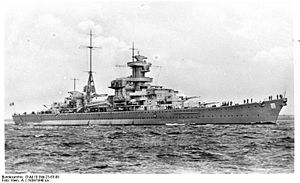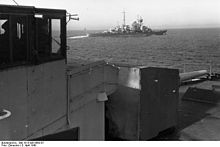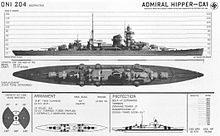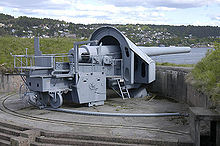- German cruiser Blücher
-

Blücher while on trialsCareer (Nazi Germany) 
Name: Blücher Namesake: Gebhard Leberecht von Blücher Laid down: 15 August 1936 Launched: 8 June 1937 Commissioned: 20 September 1939 Fate: Sunk in the Battle of Drøbak Sound on 9 April 1940 General characteristics Class and type: Admiral Hipper-class cruiser Displacement: Design: 16,170 t (15,910 long tons; 17,820 short tons)
Full load: 18,200 long tons (18,500 t)Length: 203.2 m (666 ft 8 in) overall Beam: 22 m (72 ft 2 in) Draft: Full load: 7.2 m (24 ft) Propulsion: 3 × Blohm & Voss steam turbines
3 × three-blade propellers
132,000 shp (98 MW)Speed: 32 knots (59 km/h; 37 mph) Complement: 42 officers
1,340Armament: 8 × 20.3 cm (8.0 in) guns
12 × 10.5 cm (4.1 in) guns
12 × 3.7 cm (1.5 in) guns
8 × 2 cm (0.79 in) guns (20×1)
6 × 53.3 cm (21 in) torpedo tubesArmor: Belt: 70 to 80 mm (2.8 to 3.1 in)
Armor deck: 20 to 50 mm (0.79 to 2.0 in)
Turret faces: 105 mm (4.1 in)Aircraft carried: 3 aircraft Aviation facilities: 1 catapult Blücher was the second of five Admiral Hipper class heavy cruisers of the German Kriegsmarine, built after the rise of the Nazi Party and the repudiation of the Treaty of Versailles. Named for Gebhard Leberecht von Blücher, the victor of the Battle of Waterloo, the ship was laid down in August 1936 and launched in June 1937. She was completed in September 1939, shortly after the outbreak of World War II. After completing a series of sea trials and training exercises, the ship was pronounced ready for service with the fleet on 5 April 1940.
Assigned to Group 5 during the invasion of Norway in April 1940, Blücher served as Konteradmiral Oskar Kummetz's flagship. The ship led the flotilla of warships into the Oslofjord on the night of 8 April, to seize Oslo, the capital of Norway. Two old 28 cm (11 in) coastal guns in the Oscarsborg Fortress engaged the ship at very close range, scoring two hits.[1] Two torpedoes fired by land-based torpedo batteries struck the ship, causing serious damage. A major fire broke out aboard Blücher, which could not be contained. After a magazine explosion, the ship slowly capsized and sank, with major loss of life. The wreck remains on the bottom of the Oslofjord.
Contents
Construction
Main article: Admiral Hipper class cruiserBlücher was ordered by the Kriegsmarine from the Deutsche Werke shipyard in Kiel.[2] Her keel was laid on 15 August 1936,[3] under construction number 246.[2] The ship was launched on 8 June 1937, and was completed slightly over two years later, on 20 September 1939, the day she was commissioned into the German fleet.[4] As built, the ship had a straight stem, though after her launch this was replaced with a clipper bow increasing the over all length to 205.9 meters (676 ft).[5] A raked funnel cap was also installed.[6]
As launched Blücher was 202.8 meters (665 ft) long overall and had a beam of 21.3 m (70 ft) and a maximum draft of 7.74 m (25.4 ft).[5] The ship had a design displacement of 16,170 t (15,910 long tons; 17,820 short tons) and a full load displacement of 18,200 long tons (18,500 t). Blücher was powered by three sets of geared steam turbines, which were supplied with steam by twelve ultra-high pressure oil-fired boilers. The ship's top speed was 32 knots (59 km/h; 37 mph), at 132,000 shaft horsepower (98,000 kW).[2] As designed, her standard complement consisted of 42 officers and 1,340 enlisted men.[7]
Blücher's primary armament was eight 20.3 cm (8.0 in) SK L/60 guns mounted in four twin gun turrets, placed in superfiring pairs forward and aft.[Note 1] Her anti-aircraft battery consisted of twelve 10.5 cm (4.1 in) L/65 guns, twelve 3.7 cm (1.5 in) guns, and eight 2 cm (0.79 in) guns. The ship also would have carried a pair of triple 53.3 cm (21.0 in) torpedo launchers abreast of the rear superstructure. The ship was equipped with three Arado Ar 196 seaplanes and one catapult.[7] Blücher's armored belt was 70 to 80 mm (2.8 to 3.1 in) thick; her upper deck was 12 to 30 mm (0.47 to 1.2 in) thick while the main armored deck was 20 to 50 mm (0.79 to 2.0 in) thick. The main battery turrets had 105 mm (4.1 in) thick faces and 70 mm thick sides.[2]
Service history
Blücher spent the majority of November 1939 finishing fitting out work and finishing additional improvements. By the end of the month, the ship was ready for sea trials; the ship steamed to Gotenhafen in the Baltic Sea.[8] Trials lasted until mid-December, after which the ship returned to Kiel for final modifications. In January 1940, the ship resumed exercises in the Baltic, but by the middle of the month, severe ice forced the ship to remain in port. On 5 April, the ship was deemed to be ready for action, and was therefore assigned to the forces participating in the invasion of Norway.[9]
Operation Weserübung
Main article: Operation WeserübungOn 5 April 1940, Konteradmiral Oskar Kummetz came aboard the ship while it was in Swinemünde. An 800-strong detachment of ground troops from the 163rd Infantry Division also boarded. Three days later, on 8 April, Blücher left port, bound for Norway; the ship was the flagship for the force that was to seize Oslo, the Norwegian capital. Organized as Group 5 of the invasion force,[10] the heavy cruiser Lützow and light cruiser Emden, and several smaller escorts steamed alongside Blücher. While steaming through the Kattegat and Skagerrak, the British submarine Triton spotted the convoy and fired a spread of torpedoes. The Germans successfully evaded the torpedoes, however, and proceeded with the mission.[9]
 Blücher steaming to Norway, as seen from the light cruiser Emden
Blücher steaming to Norway, as seen from the light cruiser Emden
Night had fallen by the time the German flotilla reached the approaches to the Oslofjord. Shortly after 23:00 (Norwegian time) the flotilla was spotted by the Norwegian patrol boat Pol III. The German torpedo boat Bolærne and Rauøy illuminated the ships, though the guns held their fire.[9] At 23:30 (Norwegian time) the south battery on Rauøy spotted the flotilla in the searchlight and shot two warning shots.[12] Five minutes later, the guns at Rauøy fired four shots at the approaching Germans, but due to poor visibility, scored no hits.[12] The guns at Bolærne fired only one warning shot at 23:32. Before Blücher was targeted she was out of firing sector.[13]
The German flotilla steamed at a speed of 12 kn (22 km/h; 14 mph).[14] Shortly after midnight (Norwegian time) an order from the Commanding Admiral to extinguish all light houses and navigation lights was broadcasted over NRK.[15] The German ships had been ordered to fire only in the event they were directly fired on first.[9] Between 00:30 and 02:00, the flotilla stopped and 150 infantrymen of the landing forces were transferred to the escorts R17, R21 from Emden and R18, R19 from Blücher.[16]
The R-boats should engage Rauøy, Bolærne and the naval port and city Horten.[16] Despite the apparent loss of surprise, the Blücher proceeded further into the fjord to continue with the timetable to reach Oslo by dawn. At 04:40, Norwegian searchlights again illuminated the ship. Forty-one minutes later, the 28 cm (11 in) coastal guns placed at the Oscarsborg Fortress opened fire on Blücher, beginning the Battle of Drøbak Sound. The coastal guns scored several hits on her port side at very close range.[9] The the first two 28 cm shots were on Blücher's port side. The first hit was high above the bridge, hitting the battle station for the commander of the anti-aircraft guns, killing AO II Kapitänleutnant Hans-Erich Pochhammer.[17] The main range finder in the top of the battle mast was set out of alignment, but Blücher had three more major range finders (B-turret, bridge roof and C-turret) and many smaller on the bridge and the four range finder stations for the AA. The commander in the D-turret, Oberstückmeister Waldeck stated that the first 28 cm hit had no influence on the battle ability of the 20.3 cm turrets.[18]
The second 28 cm hit caused serious damage: it hit near the aircraft hangar and started a major fire. As the fire spread, it detonated explosives carried for the infantry, further hindering fire fighting efforts.[17] The explosion set fire to the two Arado seaplanes onboard; one on the catapult and the other in one of the hangars.[19] The explosion also probably knocked a hole in the armored deck over the turbine room. Turbine 1 stopped and only the outboard shafts were operational.[20]
The Germans were unable to locate the source of the gunfire. Blücher increased speed to 32 kn (59 km/h; 37 mph) in an attempt to move past the Norwegian guns.[9] The 15 cm (5.9 in) guns on Drøbak, some 400 yd (370 m) on Blücher's starboard side, opened fire as well.[21] First engineer Leitende Ingenieur Fregattenkapitän Dip. Ing. Karl Thannemann wrote in his report that the hits from the guns on Drøbak, which were fired on the starboard side, were all between section IV and X in a length of 75 meters amidships, between B-turret and C-turret. However, all scores were on the port side.[22]
After the first salvo from the 15 cm batteries in Drøbak, the steering from the bridge was disabled. Blücher had just passed Drøbakgrunnen and was in a turn to port. The commander got her on track by using the side shafts, but she lost speed.[23] Normally the rudder is controlled electrically from the bridge to the motors forward of the Handsteuerraum (hand steering room) deep under the armored deck, forward of the rudder. In an emergency it can be switched within seconds to hand steering.[24] At 05:30, Norwegian land-based torpedo batteries scored two hits on the ship.[21] The targeting device in the torpedo battery was very primitive. The speed of the torpedo was known and set, the speed of the target had to be set by guessing.[25]
According to Admiral Kummetz' report, the first torpedo hit Kesselraum 2 (boiler 2) (just under the funnel) and the second hit turbinenraum 2/3 (turbine room for the side shafts). Boiler 1 was already destroyed by the gun fire. Only one boiler remained, but all steam pipes through boiler 1 and 2 and turbine room 2/3 was damaged and turbine 1 for the main shaft lost its power.[23] By 05:34, the ship had been severely damaged, but had successfully passed through the firing zone; the Norwegian guns could no longer train to engage the ship. The ship's rudder was jammed to port, however, and the port shaft had to be stopped and the starboard shaft had to be run at full speed back so the ship could remain on a straight course.[21]
After passing the gun batteries, Blücher crew, including the personnel manning the gun batteries, were tasked with fighting the fire. She had by that time taken on a list of 18 degrees, though this was not initially problematic. The fire reached one of the ship's 10.5 cm ammunition magazines between turbine room 1 and turbine room 2/3, however, which exploded violently. The blast ruptured several bulkheads in the engine rooms and ignited the ship's fuel stores.[21] The battered ship slowly began to capsize and the order to abandon ship was given.[26] Blücher rolled over and sank at 07:30, with significant casualties.[27] Naval historian Erich Gröner states that the number of casualties is unknown,[4] but Henrik Lunde gives the figure at around 1,000 soldiers and sailors.[14] Jürgen Rohwer meanwhile states that 125 seamen and 195 soldiers died in the sinking.[28]
The loss of Blücher and the damage done to Lützow forced the German force to withdraw. The ground troops were landed on the eastern side of the fjord; they proceeded inland and captured the Oscarborg Fortress by 09:00 on 10 April. They then moved on to attack the capital. Airborne troops captured the Fornebu Airport and completed the encirclement of the city, and by 14:00 on 10 April the city was in German hands. The delay caused by the temporary withdrawal of Blücher's task force, however, allowed the Norwegian government and royal family to escape the city.[14]
Blücher remains at the bottom of the Drøbak Narrows, at a depth of 35 fathoms (210 ft; 64 m).[29] The ship's screws were removed in 1953, and there have been several proposals to raise the wreck since 1963, but none have been carried out.[4] When Blücher left Germany, she had about 2,670 cubic metres (94,000 cu ft) of oil onboard. She expended some of the fuel en route to Norway, and some was lost in the sinking, but she was constantly leaking oil. In 1991 the leakage rate increased to 50 liters (11 imp gal; 13 U.S. gal) per day, threatening the environment. The Norwegian government therefore decided to remove as much oil as possible from the wreck. In October 1994 the company Rockwater AS together with deep sea divers drilled holes in 133 fuel tanks and removed 1,000 t (980 long tons; 1,100 short tons) of oil; 47 fuel bunkers were unreachable and may still contain oil. After being run through a cleaning process, the oil was sold. The oil extraction operation provided an opportunity to recover one of Blücher's two Arado 196 aircraft. The plane was raised on 9 November 1994 and is currently at the Flyhistorisk Museum, Sola aviation museum near Stavanger.[30]
Footnotes
- Notes
- ^ "L/60" denotes the length of the gun in terms of calibers. The length of 60 caliber gun is 60 times greater than it is wide in diameter.
- Citations
- ^ Binder & Schlünz (1. ed.), p. 90
- ^ a b c d Gröner, p. 65
- ^ Williamson, p. 22
- ^ a b c Gröner, p. 67
- ^ a b Koop & Schmolke, p. 13
- ^ Williamson, p. 35
- ^ a b Gröner, p. 66
- ^ Williamson, pp. 23–24
- ^ a b c d e f Williamson, p. 24
- ^ Rohwer, p. 18
- ^ Tamerlander & Zetterling, p. 72
- ^ a b Fjeld et. al. p. 179
- ^ Fjeld et. al. p. 180
- ^ a b c Lunde, p. 220
- ^ Berg, p. 9
- ^ a b Binder & Schlünz, p. 74
- ^ a b Binder & Schlünz, p. 92
- ^ Binder & Schlünz, p. 119
- ^ Binder & Schlünz, p. 93
- ^ Binder & Schlünz, p. 126
- ^ a b c d Williamson, p. 33
- ^ Binder & Schlünz, p. 83
- ^ a b Koop & Schmolke, p. 126
- ^ Koop & Schmolke, p. 42
- ^ A.n. Hovland;Centralsikteapparat for torpedobatteriet, Verdens Gang 13. April and 6. May 1953. (Comments by the inventor of the targeting device)
- ^ Williamson, pp. 33–34
- ^ Williamson, p. 34
- ^ Rohwer, p. 19
- ^ Gardiner and Chesneau, p. 229
- ^ Binder & Schlünz, p. 180
References
- Berg, Ole F (1997) (in Norwegian). I skjærgården og på havet, Marinens krig 8. april 1940 – 8 mai 1945. Marinens krigsveteranforening. ISBN 82-993545-2-8.
- Binder, Frank; Hans Hermann Schlünz (1990) (in German). Schwerer Kreuzer Blücher. Koehlers Verlagsgesellschaft. ISBN 3-7822-0487-5.
- Fjeld, Odd T; Tor Jørgen Melien, Jan Egil Fjørtoft, Tor Georg Monsen, Reidar Lauritz Godø, Robert Eichinger (1999) (in Norwegian). Klar til strid, Kystartilleriet gjennom århundrene|Utgitt av Kystartilleriets Offisersforening. ISBN 82-995208-0-0.
- Gardiner, Robert; Chesneau, Roger (1980). Conway's All the World's Fighting Ships, 1922–1946. Annapolis, MD: Naval Institute Press. ISBN 0870219138.
- Gröner, Erich (1990). German Warships: 1815–1945. Annapolis, MD: Naval Institute Press. ISBN 0870217909.
- Koop, Gerhard; Klaus-Peter Schmolke (1992) (in German). Die Schwere Kreuzer der Admiral Hipper-klasse. Bernard&Graefe Verlag. ISBN 3-7637-5896-8.
- Lunde, Henrik O. (2010). Hitler's Pre-Emptive War: The Battle for Norway, 1940. Havertown, PA: Casemate Publishers. ISBN 9781935149330.
- Rohwer, Jürgen (2005). Chronology of the War at Sea, 1939–1945: The Naval History of World War Two. Annapolis: US Naval Institute Press. ISBN 1-59114-119-2.
- Tamelander, Michael; Niklas Zetterling (2001) (in Norwegian). 9. april, Nazitysklands invasjon av Norge. Spartacus forlag AS. ISBN 82-430-0191-3.
- Williamson, Gordon (2003). German Heavy Cruisers 1939–1945. Oxford: Osprey Publishing. ISBN 9781841765020.
- Admiral Hipper
- Blücher
- Prinz Eugen
- Seydlitz
- Lützow
- List of heavy cruisers of Germany
Categories:- Admiral Hipper class cruisers
- Ships built in Kiel
- 1937 ships
- World War II cruisers of Germany
- World War II shipwrecks in the North Sea
- Maritime incidents in 1940
Wikimedia Foundation. 2010.


